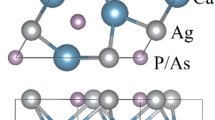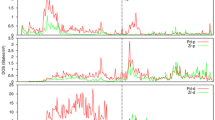Abstract
Thermal stability of a series of B-doped diamond models has been resolved by means of the simulations. And the accuracy of the model is proved by simulation computation. It was performed by adopting the first-principles calculation of plane wave ultra-soft pseudo-potential technology based upon the density function theory. The calculated values of cohesive energy and heats of formation showed that B4C60 has the weakest crystal stability, and lowest structure stability. Lattice constant, elastic constant have been calculated. Cohesive energy, heats of formation, Debye temperature is discussed. The calculation values of bulk moduli, shear moduli, Young’s moduli and Poisson ratio have also been given. The electronic properties of these B-doped models have been investigated using the functional theory within a local density approximation.









Similar content being viewed by others
References
Field, J.E.: The properties of diamond. Academic Press, Cambridge (1979)
Yoshida, K., Morigami, H.: Thermal properties of diamond/copper composite material. Microelectron. Reliab. 44(2), 303–308 (2004)
Yuan, Z.J., Zhou, M., Dong, S.: Effect of diamond tool sharpness on minimum cutting thickness and cutting surface integrity in ultra precision machining. J. Mater. Process. Technol. 62(4), 327–330 (1996)
Wentorf, R.H., Rocco, W.A.: Diamond tools for machining: US, US3745623 (1973)
Chrenko, R.M.: Boron, the dominant acceptor in semiconducting diamond. Phys. Rev. B 7(10), 4560 (1973)
Takano, Y., Nagao, M., Tachiki, M., et al.: Superconductivity in boron-doped diamond thin film. US, US 7976893 B2 (2011)
Gong, J.H., Mu-Sen, L.I., Yong-Xin, Q.I., et al.: Study on the crystal structure and oxidation resistance of boron-doped synthetic diamond. Superhard Mater. Eng. 4, 019 (2009)
Linares, R.C.: Boron-doped diamond semiconductor. US, US8158455 (2012)
Bustarret, E., Kacmarcik, J., Marcenat, C., et al.: Dependence of the superconducting transition temperature on the doping level in single-crystalline diamond films. Phys. Rev. Lett. 93(23), 237005 (2004)
Wang, Z.L., Luo, Q., Liu, L.W., et al.: The superconductivity in boron-doped polycrystalline diamond thick films. Diam. Relat. Mater. 15(4–8), 659–663 (2006)
Kopelevich, Y., Esquinazi, P.: Ferromagnetism and superconductivity in carbon-based systems. J. Low Temp. Phys. 146(5–6), 629–639 (2007)
Umezawa, H., Takenouchi, T., Takano, Y., et al.: Advantage on superconductivity of heavily boron-doped (111) diamond films. Physics (2005)
Winzer, K., Bogdanov, D., Wild, C.: Electronic properties of boron-doped diamond on the border between the normal and the superconducting state. Physica C (Amsterdam, Neth.) 432(1–2), 65–70 (2005)
Bustarret, E., Achatz, P., Sacépé, B., et al.: Metal-to-insulator transition and superconductivity in boron-doped diamond. Phys. Rev. B 75(16), 1418–1428 (2007)
Ma, Y., Tse, J.S., Cui, T., Klug, D.D., Zhang, L., Xie, Y., Niu, Y., Zou, G.: First-principles study of electron-phonon coupling in hole-and electron-doped diamonds in the virtual crystal approximation. Phys. Rev. B 72, 014306 (2005)
Blase, X., Adessi, C., Connétable, D.: Superconductivity in boron-doped diamond. Phys. Rev. Lett. 93(23), 237003 (2004)
Xiang, H.J., Li, Z., Yang, J., et al.: Electron-phonon coupling in boron-doped diamond superconductor. Phys. Rev. B 70(21), 155–163 (2004)
Sque, S.J., Jones, R., Briddon, P.R.: Structure, electronics, and interaction of hydrogen and oxygen on diamond surfaces. Phys. Rev. B 73(8), 085313 (2006)
Giustino, F., Yates, J.R., Souza, I., et al.: Electron-phonon interaction via electronic and lattice Wannier functions: superconductivity in boron-doped diamond reexamined. Phys. Rev. Lett. 98(4), 047005 (2007)
Bourgeois, E., Bustarret, E., Achatz, P., et al.: Impurity dimers in superconducting B-doped diamond: experiment and first-principles calculations. Phys. Rev. B 74(9), 094509 (2006)
Long, R., Dai, Y., Guo, M., Yu, L., Huang, B.B., Zhang, R.Q., Zhang, W.J.: Effect of B-complexes on lattice structure and electronic properties in heavily boron-doped diamond. Diam. Relat. Mater. 17, 234 (2008)
Zhang, R.J., Lee, S.T., Lam, Y.W.: Characterization of heavily boron-doped diamond films. Diam. Relat. Mater. 5(5), 1288–1294 (1996)
Ushizawa, K., Watanabe, K., Ando, T., Sakaguchi, I., Nishitani-Gamo, M., Sato, Y., Kanda, H.: Boron concentration dependence of Raman spectra on {100} and {111} facets of B-doped CVD diamond. Diam. Relat. Mater. 7, 1719 (1998)
Suli: Microstructure and properties of boron-dopped diamond synthesized by fe-based catalyst. Doctoral dissertation, Shandong University
Stotter, J., Zak, J., Behler, Z., et al.: Optical and electrochemical properties of optically transparent, boron-doped diamond thin films deposited on quartz. Anal. Chem. 74(23), 5924–5930 (2003)
Unwin, P., Macpherson, J., Newton, M.: Boron-doped diamond: EP, WO/2010/029277 (2010)
Payne, M.C.: MC Payne, MP Teter, DC Allan, TA Arias, and JD Joannopoulos, Rev. Mod. Phys. 64, 1045 (1992). Rev. Mod. Phys. 64, 1045 (1992)
Tiwari, A.K., Goss, J.P.: Electronic and structural properties of diamond (001) surfaces terminated by selected transition metals. Phys. Rev. B 86(15), 155301 (2012)
Long, Run: Diamond and zinc nitride semiconductor electronic properties. Shandong University, Jinan (2008)
Acknowledgements
The numerical calculations in this paper have been done on the supercomputing system in the Supercomputing Center, Shandong University, Weihai. And this paper is supported by the Natural Science Foundation of Shandong Province (No. ZR2014EMM011).
Author information
Authors and Affiliations
Corresponding author
Rights and permissions
About this article
Cite this article
Li, J., Gong, J., Chen, Q. et al. The first-principle calculation method for thermal structure stability analysis based on the simulation and sensing on cohesive energy. Cluster Comput 22 (Suppl 3), 6197–6208 (2019). https://doi.org/10.1007/s10586-018-1897-5
Received:
Revised:
Accepted:
Published:
Issue Date:
DOI: https://doi.org/10.1007/s10586-018-1897-5




